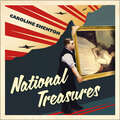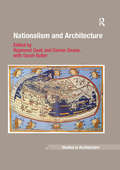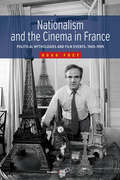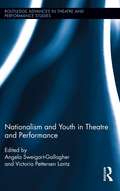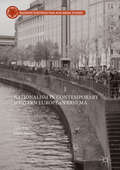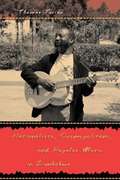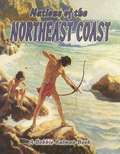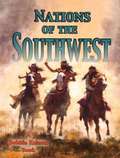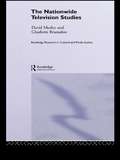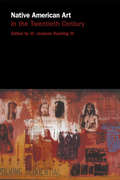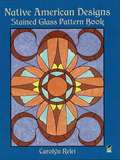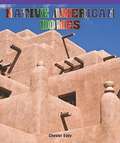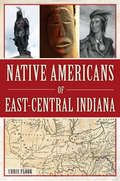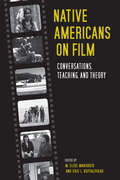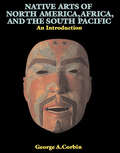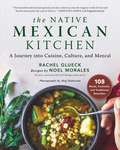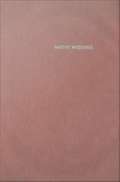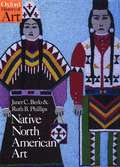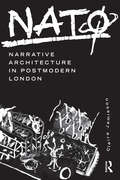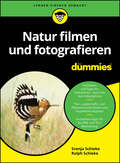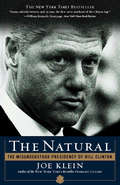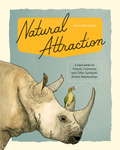- Table View
- List View
National Treasures: Saving The Nation's Art in World War II
by Caroline ShentonThe gigantic covert wartime mission led by the men and women of London's museums and galleries to save the nation's priceless heritage.As Hitler prepared to invade Poland during the sweltering summer of 1939, men and women from across London's museums, galleries and archives formulated ingenious plans to send the nation's highest prized objects to safety. Using stately homes, tube tunnels, slate mines, castles, prisons, stone quarries and even their own homes, a dedicated bunch of unlikely misfits packed up the nation's greatest treasures and, in a race against time, dispatched them throughout the country on a series of top-secret wartime adventures. National Treasures highlights a moment from our history when an unlikely coalition of mild-mannered civil servants, social oddballs and metropolitan aesthetes became the front line in the heritage war against Hitler. Caroline Shenton shares the interwoven lives of ordinary people who kept calm and carried on in the most extraordinary of circumstances in their efforts to save the Nation's historic identity.(P) 2021 Hodder & Stoughton Limited
Nationalism and Architecture (Ashgate Studies in Architecture)
by Darren Deane Sarah ButlerUnlike regionalism in architecture, which has been widely discussed in recent years, nationalism in architecture has not been so well explored and understood. However, the most powerful collective representation of a nation is through its architecture and how that architecture engages the global arena by expressing, defining and sometimes negating a sense of nation in order to participate in the international world. Bringing together case studies from Europe, North and South America, the Middle East, Africa, Asia and Australia, this book provides a truly global exploration of the relationship between architecture and nationalism, via the themes of regionalism and representation, various national building projects, ethnic and trans-national expression, national identities and histories of nationalist architecture and the philosophies and sociological studies of nationalism. It argues that nationalism needs to be trans-national as a notion to be critically understood and the geographical scope of the proposed volume reflects the continuing relevance of the topic within current architectural scholarship as an overarching notion. The interdisciplinary essays are coherently grouped together in three thematic sections: Revisiting Nationalism, Interpreting Nationalism and Questioning Nationalism. These chapters, offer vignettes of the protean appearances of nationalism across nations, and offer a basis of developing wider knowledge and critically situated understanding of the question, beyond a singular nation's limited bounds.
Nationalism and the Cinema in France: Political Mythologies and Film Events, 1945-1995
by Hugo FreyIt is often taken for granted that French cinema is intimately connected to the nation's sense of identity and self-confidence. But what do we really know about that relationship? What are the nuances, insider codes, and hidden history of the alignment between cinema and nationalism? Hugo Frey suggests that the concepts of the 'political myth' and 'the film event' are the essential theoretical reference points for unlocking film history. Nationalism and the Cinema in France offers new arguments regarding those connections in the French case, examining national elitism, neo-colonialism, and other exclusionary discourses, as well as discussing for the first time the subculture of cinema around the extreme right Front National. Key works from directors such as Michel Audiard, Jean-Luc Godard, Jean-Pierre Melville, Marcel Pagnol, Jean Renoir, Jacques Tati, François Truffaut, and others provide a rich body of evidence.
Nationalism and Youth in Theatre and Performance (Routledge Advances in Theatre & Performance Studies)
by Angela Sweigart-Gallagher Victoria Pettersen LantzNationalism and Youth in Theatre and Performance explores how children and young people fit into national political theatre and, moreover, how youth enact interrogative, patriotic, and/or antagonistic performances as they develop their own relationship with nationhood. Children are often seen as excluded from public discourse or political action. However, this idea of exclusion is false both because adults place children at the center of political debates (with the rhetoric of future generations) and because children actively insert themselves into public discourse. Whether performing a national anthem for visiting heads of state, creating a school play about a country’s birth, or marching in protest of a change in public policy, young people use theatre and performance as a means of publicly staking a claim in national politics, directly engaging with ideas of nationalism around the world. This collection explores the issues of how children fit into national discourse on international stages. The authors focus on national performances by/for/with youth and examine a wide range of performances from across the globe, from parades and protests to devised and traditional theatre. Nationalism and Youth in Theatre and Performance rethinks how national performance is defined and offers previously unexplored historical and theoretical discussions of political youth performance.
Nationalism in Contemporary Western European Cinema (Palgrave European Film and Media Studies)
by James HarveyThis book investigates screen representations of 21st century nationalism—arguably the most urgent and apparent phenomenon in the Western world today. The chapters explore recurrent thematic and stylistic features of 21st century western European cinema, and analyse the ways in which film responds to contemporary developments of mounting tensions and increasing hostilities to difference. The collection blends incisive sociological and historical engagement with close textual analysis of many types of screen media, including popular cinema, art-house productions, low-budget independent work, documentary and video installation. Identifying motifs of nationhood and indigeneity throughout, the contributors of this volume present important perspectives and a timely cultural response to the contemporary moment of nationalism.
Nationalists, Cosmopolitans, and Popular Music in Zimbabwe
by Thomas TurinoThe book talks about how cosmopolitanism gave rise to the nationalist movement in Zimbabwe, explaining the combination of "foreign" and indigenous elements that define nationalist art and cultural projects.
Nations Of The Northeast Coast
by Molly Aloian Bobbie KalmanNations of the Northeast Coast describes the many Native nations that lived along the coast of northeastern North America during the seventeenth century. Young readers will be fascinated to learn about the hunting and fishing practices, the methods of transportation, and the family lives of these Native peoples.
Nations of the Southwest
by Bobbie Kalman Amanda BishopThe Southwest region was home to some of the earliest inhabitants of North America. The diverse landscapes of deserts, mountains, and rivers provided food, shelter, and raw materials to ancient cultures as well as later groups, such as the Apache, Comanche, Hopi, Navajo, Zuni, and many others.
The Nation's Stage: The John F. Kennedy Center for the Performing Arts
by Michael Dolan Michael Kaiser David M. Rubenstein"There is a connection, hard to explain logically but easy to feel, between achievement in public life and progress in the arts. The age of Pericles was also the age of Phidias. The age of Lorenzo de Medici was also the age of Leonardo da Vinci. The age of Elizabeth was also the age of Shakespeare, and the new frontier for which I campaign in public life can also be a new frontier for American art." --John F. Kennedy When the John F. Kennedy Center for the Performing Arts opened in our nation's capital on September 8, 1971, its mission was to be the "national center for the performing arts." Forty years later the Center has succeeded in that mission and continues to celebrate it--countless times over--in every state and country around the world, and in the hearts and minds of millions of audience members, performers, and artists. In The Nation's Stage, that history comes alive through a stirring historical and pictorial narrative. An incubator and springboard for some of the most memorable and important theater, dance, opera, and musical productions of the past four decades, the Center has hosted plays by Tennessee Williams, Arthur Miller, Tom Stoppard, and August Wilson, as well as theater for young people with Debbie Allen; dance by Antony Tudor, Agnes de Mille, Mark Morris, and Jerome Robbins; orchestral scores by Leonard Bernstein, Aaron Copland, Dmitri Shostakovich, and John Cage; and breathtaking performances from the world's most notable actors, musicians, and dancers. Every year, millions of Americans and people from around the globe gather at the Center to enjoy the arts. This book, an introduction to the Center's accomplishments and abilities and a commemorative artifact for those who have enjoyed those gifts over the years, is a historical narrative with hundreds of colorful archival photos that allow past audiences to relive the most magical moments at the Center. Those who've never been inside receive a backstage pass to all the glamour and wonder this national treasure has to offer.
The Nationwide Television Studies (Routledge Research in Cultural and Media Studies)
by Charlotte Brunsdon David MorleyThis book brings together for the first time David Morley and Charlotte Brunsdon's classic texts, Everyday Television: Nationwide and The Nationwide Audience. Originally published in 1978 and 1980 these two research projects combine innovative textual readings and audience analysis of the BBC's current affairs programme Nationwide. In a specially written introduction the authors trace the history of the original Nationwide project and clarify the origins of the two books.
Native American Architecture
by Peter Nabokov Robert EastonFor many people, Native American architecture calls to mind the wigwam, tipi, iglu, and pueblo. Yet the richly diverse building traditions of Native Americans encompass much more, including specific structures for sleeping, working, worshipping, meditating, playing, dancing, lounging, giving birth, decision-making, cleansing, storing and preparing food, caring for animals, and honoring the dead. In effect, the architecture covers all facets of Indian life. The collaboration between an architect and an anthropologist, Native American Architecture presents the first book-length, fully illustrated exploration of North American Indian architecture to appear in over a century. Peter Nabokov and Robert Easton together examine the building traditions of the major tribes in nine regional areas of the continent from the huge plank-house villages of the Northwest Coast to the moundbuilder towns and temples of the Southeast, to the Navajo hogans and adobe pueblos of the Southwest. Going beyond a traditional survey of buildings, the book offers a broad, clear view into the Native American world, revealing a new perspective on the interaction between their buildings and culture. Looking at Native American architecture as more than buildings, villages, and camps, Nabokov and Easton also focus on their use of space, their environment, their social mores, and their religious beliefs. Each chapter concludes with an account of traditional Indian building practices undergoing a revival or in danger today. The volume also includes a wealth of historical photographs and drawings (including sixteen pages of color illustrations), architectural renderings, and specially prepared interpretive diagrams which decode the sacred cosmology of the principal house types.
Native American Art in the Twentieth Century: Makers, Meanings, Histories
by W. Jackson Rushing IIIThis illuminating and provocative book is the first anthology devoted to Twentieth Century Native American and First Nation art. Native American Art brings together anthropologists, art historians, curators, critics and distinguished Native artists to discuss pottery, painitng, sculpture, printmaking, photography and performance art by some of the most celebrated Native American and Canadian First Nation artists of our timeThe contributors use new theoretical and critical approaches to address key issues for Native American art, including symbolism and spirituality, the role of patronage and musuem practices, the politics of art criticism and the aesthetic power of indigenous knowledge. The artist contributors, who represent several Native nations - including Cherokee, Lakota, Plains Cree, and those of the PLateau country - emphasise the importance of traditional stories, myhtologies and ceremonies in the production of comtemporary art. Within great poignancy, thye write about recent art in terms of home, homeland and aboriginal sovereigntyTracing the continued resistance of Native artists to dominant orthodoxies of the art market and art history, Native American Art in the Twentieth Century argues forcefully for Native art's place in modern art history.
Native American Designs Stained Glass Pattern Book
by Carolyn ReleiStained glass workers in search of handsome, high-quality patterns will welcome this collection of designs based on traditional Native American themes. Approximately 120 identified patterns -- shown as insets on the pattern page -- have been adapted from authentic tribal motifs.Here are striking designs fashioned after motifs from Seminole beadwork, an Apache basket, an Acoma polychrome vessel, pottery from the Santo Domingo Pueblo in New Mexico, an Arapaho rawhide bag, Zuni and Hopi pottery, New Mexican Laguna jars, Jicarilla Apache basketry, an altar with feathers, a Navajo weave of Germantown yarn, a Hopi ceremonial blanket, a detail of Mayan stonework from the Yucatan Peninsula, images from a Nez Percé woven bag, a thunderbird figure on a shaman's rattle from the Pacific Northwest, a design on a Blackfoot cradleboard (late nineteenth century), eagle feathers in an abstract design, and much more.Shown in circular, rectangular, diamond-like, and other shapes, these dramatic, decorative elements can be incorporated into stained glass and other imaginative craft projects.
Native American Homes (Real Life Readers)
by Lincoln JamesExplore the great variety of the first peoples of America through a look at traditional homes, from longhouses to teepees, to adobe villages. Correlated to the Informational Text Standards from the Common Core, readers glean a look at America's first homes, with high quality photographs and key text features.
Native Americans of East-Central Indiana (American Heritage)
by Chris FlookNative Americans lived, hunted and farmed in east-central Indiana for two thousand years before the area became a part of the Hoosier State. Mounds and enclosures built by Adena and Hopewell peoples still stand near the White River and reflect their vibrant and mysterious cultures. The Lenape tribes moved to east-central Indiana many years later after the Northwest Indian War. Led by the great chiefs Buckhongehelas and Kikthawenund, the White River Lenape attempted to forge an identity after being forced from their homeland on the Atlantic coast. Place names like Delaware County, Muncie, Yorktown and Anderson demonstrate the importance of the tribe in local history. Author Chris Flook explores the unique yet often untold history of the Native experience in east-central Indiana.
Native Americans on Film: Conversations, Teaching, and Theory
by M. Elise Marubbio and Eric L. Buffalohead“An essential book for courses on Native film, indigenous media, not to mention more general courses . . . A very impressive and useful collection.” —Randolph Lewis, author of Navajo Talking PictureThe film industry and mainstream popular culture are notorious for promoting stereotypical images of Native Americans: the noble and ignoble savage, the pronoun-challenged sidekick, the ruthless warrior, the female drudge, the princess, the sexualized maiden, the drunk, and others. Over the years, Indigenous filmmakers have both challenged these representations and moved past them, offering their own distinct forms of cinematic expression.Native Americans on Film draws inspiration from the Indigenous film movement, bringing filmmakers into an intertextual conversation with academics from a variety of disciplines. The resulting dialogue opens a myriad of possibilities for engaging students with ongoing debates: What is Indigenous film? Who is an Indigenous filmmaker? What are Native filmmakers saying about Indigenous film and their own work? This thought-provoking text offers theoretical approaches to understanding Native cinema, includes pedagogical strategies for teaching particular films, and validates the different voices, approaches, and worldviews that emerge across the movement.“Accomplished scholars in the emerging field of Native film studies, Marubbio and Buffalohead . . . focus clearly on the needs of this field. They do scholars and students of Native film a great service by reprinting four seminal and provocative essays.” —James Ruppert, author of Meditation in Contemporary Native American Literature“Succeed[s] in depicting the complexities in study, teaching, and creating Native film . . . Regardless of an individual’s level of knowledge and expertise in Native film, Native Americans on Film is a valuable read for anyone interested in this topic.” —Studies in American Indian Literatures
Native Arts Of North America, Africa, And The South Pacific: An Introduction
by George A. CorbinThis introduction to the art of tribal peoples of North America, Africa, and the South Pacific does not briefly cover the hundreds of artistic traditions in these three vast areas but rather studies in depth thirty-six art styles within all three areas using the methods of art history, including stylistic analysis and iconographic interpretation. Emphasis is on the art in cultural context and as a system of visual communication within each tribal area. Where appropriate for a more complete understanding of the art, data from archaeology, ethnology, linguistics, religion, and other humanistic disciplines are included.Among the peoples and cultures whose art is studied are the Haida, Kwakiutl, and Tlingit; the Hohokam and Mongollon, the Anasazi and Hopi; the Dogon and Bamana of Mali; the Asante of Ghana; the Benin, Yoruba, and Ibo of Nigeria; the Fan, the Bamum, and the Kuba of Central Africa; Australian aboriginal and Island New Guinea art; Island Melanesia art; central and eastern Polynesia; Hawaii and the Maori in Marginal Polynesia.The format of the text and selected illustrations is based on seventeen years of teaching African, North American Indian, and South Pacific art to undergraduate and graduate students at Herbert H. Lehman College (CUNY), New York University, and Columbia University. The book is intended for art history and anthropology students and the interested lay reader or collector. The detailed notes at the end of the book are for further study, research, and understanding of the tribal art style under discussion.
Native Arts Of North America, Africa, And The South Pacific: An Introduction
by George A. CorbinThis introduction to the art of tribal peoples of North America, Africa, and the South Pacific does not briefly cover the hundreds of artistic traditions in these three vast areas but rather studies in depth thirty-six art styles within all three areas using the methods of art history, including stylistic analysis and iconographic interpretation. Emphasis is on the art in cultural context and as a system of visual communication within each tribal area. Where appropriate for a more complete understanding of the art, data from archaeology, ethnology, linguistics, religion, and other humanistic disciplines are included.Among the peoples and cultures whose art is studied are the Haida, Kwakiutl, and Tlingit; the Hohokam and Mongollon, the Anasazi and Hopi; the Dogon and Bamana of Mali; the Asante of Ghana; the Benin, Yoruba, and Ibo of Nigeria; the Fan, the Bamum, and the Kuba of Central Africa; Australian aboriginal and Island New Guinea art; Island Melanesia art; central and eastern Polynesia; Hawaii and the Maori in Marginal Polynesia.The format of the text and selected illustrations is based on seventeen years of teaching African, North American Indian, and South Pacific art to undergraduate and graduate students at Herbert H. Lehman College (CUNY), New York University, and Columbia University. The book is intended for art history and anthropology students and the interested lay reader or collector. The detailed notes at the end of the book are for further study, research, and understanding of the tribal art style under discussion.
The Native Mexican Kitchen: A Journey into Cuisine, Culture, and Mezcal
by Rachel Glueck Noel MoralesA Deep Dive into the Complex and Vibrant Native Culture that is the Bedrock of Mexican Cuisine, with Over One Hundred Recipes, Including Moles, Pozoles, Chiles en Nogada, and More Mexican cuisine is ubiquitous in the American dining scene, yet it remains far removed from its roots. The Native Mexican Kitchen is an homage to the indigenous peoples and their culinary and cultural traditions that create Mexican cuisine, elevating it beyond Americanized tacos and tequila. With recipes by Mexican chef Noel Morales—born of Aztec and Omec blood, grandson to a mezcalero, and raised by native dancers—The Native Mexican Kitchen offers its readers the ability to recreate the flavors of centuries-old dishes in a modern kitchen. Morales shares well-known plates such as birria and barbacoa, and beloved market foods like tlayudas and tacos al pastor, as well as a few of his own vegetarian and seafood creations. Signature mezcal cocktails and decadent desserts adorn these pages, while the Medicinales section includes teas, tinctures, and baths of traditionally used herbs for a variety of ailments, such as colds, muscle tension, and infertility. Author Rachel Glueck provides rare access and insight into a Mexico that few foreigners or nationals see today, leading you through indigenous festivals with masked dancers, bountiful market places, and sacred pilgrimage sites. Unwrap the philosophies and customs of Mexico&’s native communities and discover the depth of this magical country and how you can welcome it into your own kitchen. Personal stories of mezcaleros, traditional cooks, and native healers are accentuated by 130 stunning photographs and are woven through with mouth-watering recipes. With pages bursting with color, culture, and wisdom, you&’ll discover a Mexico you never knew existed.
Native Moderns: American Indian Painting, 1940-1960
by Bill AnthesBetween 1940 and 1960, many Native American artists made bold departures from what was considered the traditional style of Indian painting. They drew on European and other non-Native American aesthetic innovations to create hybrid works that complicated notions of identity, authenticity, and tradition. This richly illustrated volume focuses on the work of these pioneering Native artists, including Pueblo painters Jos Lente and Jimmy Byrnes, Ojibwe painters Patrick DesJarlait and George Morrison, Cheyenne painter Dick West, and Dakota painter Oscar Howe. Bill Anthes argues for recognizing the transformative work of these Native American artists as distinctly modern, and he explains how bringing Native American modernism to the foreground rewrites the broader canon of American modernism. In the mid-twentieth century, Native artists began to produce work that reflected the accelerating integration of Indian communities into the national mainstream as well as, in many instances, their own experiences beyond Indian reservations as soldiers or students. During this period, a dynamic exchange among Native and non-Native collectors, artists, and writers emerged. Anthes describes the roles of several anthropologists in promoting modern Native art, the treatment of Native American "Primitivism" in the writing of the Jewish American critic and painter Barnett Newman, and the painter Yeffe Kimball's brazen appropriation of a Native identity. While much attention has been paid to the inspiration Native American culture provided to non-Native modern artists, Anthes reveals a mutual cross-cultural exchange that enriched and transformed the art of both Natives and non-Natives.
Native North American Art
by Janet Catherine Berlo Ruth B. PhillipsAn exploration of the indigenous arts of the US and Canada from the early pre-Columbian period to the present day.
NATØ: Narrative Architecture in Postmodern London
by Claire JamiesonChronicling the last radical architectural group of the twentieth century – NATØ (Narrative Architecture Today) – who emerged from the Architectural Association at the start of the 1980s, this book explores the group’s work which echoed a wider artistic and literary culture that drew on the specific political, social and physical condition of 1980s London. It traces NATØ’s identification with a particular stream of post-punk, postmodern expression: a celebration of the abject, an aesthetic of entropy, and a do-it-yourself provisionality. NATØ has most often been documented in reference to Nigel Coates (the instigator of NATØ), which has led to a one-sided, one-dimensional record of NATØ’s place in architectural history. This book sets out a more detailed, contextual history of NATØ, told through photographs, drawings, and ephemera, restoring a truer polyvocal narrative of the group’s ethos and development.
Natur filmen und fotografieren für Dummies (Für Dummies)
by Svenja Schieke Ralph SchiekeFangen Sie spannende Motive in der Natur ein – mit Ihrer Kamera Schon mit wenig Ausrüstung können Sie wunderbare Momente festhalten – nicht nur in Einzelbildern, sondern auch im Film. Wie Sie Landschaften und Tiere filmen und fotografieren, lernen Sie in diesem Buch. Svenja und Ralph Schieke zeigen Ihnen Schritt für Schritt von der Planung bis zur Veröffentlichung, wie spannende und interessante Naturfotografien und Naturfilme mit dem gewissen Etwas entstehen. Sie erfahren, wie Sie Motive finden, welche Ausrüstung Sie benötigen, was Sie bei den Aufnahmen beachten müssen und wie Sie Ihre Ergebnisse weiter bearbeiten. Sie erfahren Wie Sie auch mit Ihrem Smartphone gelungene Aufnahmen machen Warum sich die Stadt nicht verstecken muss, wenn es um Naturaufnahmen gehtWie Sie einen Film planen und in der Natur Schritt für Schritt umsetzenWo Sie Ihre Aufnahmen präsentieren können
The Natural: The Misunderstood Presidency of Bill Clinton
by Joe KleinNovelist and political analyst Klein argues that for all the scandal and political disappointments, Clinton's two terms in office quietly made good times a little better and left no huge mess for the next tenant to clean up. Annotation c. Book News, Inc. , Portland, OR (booknews. com)
Natural Attraction: A Field Guide to Friends, Frenemies, and Other Symbiotic Animal Relationships
by Iris GottliebBest buds, frenemies, freeloaders, bullies, copycats, hangers-on. We’re accustomed to all types of people and human interactions. But animal relationships can be just as weird and complex. For anyone who’s ever felt a bit awkward in their relationships, wait until you hear about how complicated things get in the animal world. This funny and enlightening gift book depicts charming and unusual symbiotic animal relationships in all their awkward glory. Through delightful watercolor illustrations and funny yet scientifically accurate text, Iris Gottlieb explores the symbiotic relationships of 35 odd, cute, and unpredictable animal pairs. Here are stories of vampires, cannibalism, mimicry, parasites, and more. You’ll learn a lot about nature--and human nature--as you recognize traits of your own friends, frenemies, and enemies in this insightful, amusing look into the secret lives of animals.From the Hardcover edition.
